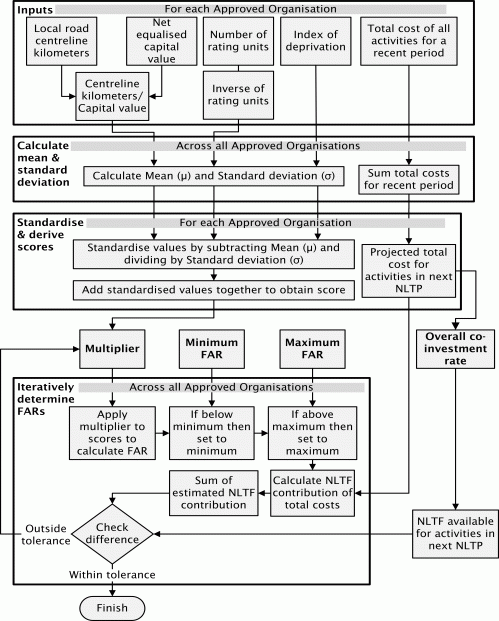Introduction |
The Transport Agency's funding assistance system was reviewed during 2012-14, revising the methodology for determining Approved Organisations' normal funding assistance rates (FARs) and changing the funding assistance policy. The revised policy applies from 1 July 2015. The background, engagement documents, submissions and decisions to the FAR The usual contribution in percentage terms, that the NZTA augments funding of an approved organisation, for the delivery of an activity or combination of activities. review can be accessed at the Transport Agency's FAR Review site.
This section sets out the Transport Agency's funding asssistance policy and describes the methodology for determing Approved Organisations' normal FARs. It also sets out arrangements to transition Approved Organisations from their starting point FARs to target normal FARs by 2023/24, and describes variations to normal FARs and their application.
In addition to this content, the following links provide related information:
The funding assistance policy and rates applicable prior to the 2015-18 NLTP A National Land Transport Programme Interrelated and complementary combination of activities that, when delivered in a coordinated manner, produce synergies – can span more than one work category and more than one activity class, e.g. a programme could include a road improvement and public transport improvement activities. adopted by the NZTA under section 19 of the LTMA, as from time to time amended or varied can be accessed at the following link: |
Role of funding assistance rates |
FARs, in conjunction with other land transport investment tools and interventions, exist to:
|
Funding assistance rate principles |
The seven principles that underlie the Transport Agency's funding assistance framework are:
|
Funding assistance rate framework |
|
Methodology for determining normal FARs |
Following engagement with Approved Organisations and interested transport sector groups, the Transport Agency developed its methodology for determining normal FARs, which take into account factors materially affecting delivery and that are robust, repeatable, stable and independent.
Inputs for each council
Parameters & definitions
Steps
The flow diagram below provides a visual representation of the steps involved in determining the FARs.
Model The model used by the Transport Agency to determine normal FARs can be accessed at this link. |
FAR The usual contribution in percentage terms, that the NZTA augments funding of an approved organisation, for the delivery of an activity or combination of activities. methodology flow diagram |
 |
Review of normal FARs prior to start of each NLTP A National Land Transport Programme Interrelated and complementary combination of activities that, when delivered in a coordinated manner, produce synergies – can span more than one work category and more than one activity class, e.g. a programme could include a road improvement and public transport improvement activities. adopted by the NZTA under section 19 of the LTMA, as from time to time amended or varied |
A year prior to the start of each NLTP A National Land Transport Programme Interrelated and complementary combination of activities that, when delivered in a coordinated manner, produce synergies – can span more than one work category and more than one activity class, e.g. a programme could include a road improvement and public transport improvement activities. adopted by the NZTA under section 19 of the LTMA, as from time to time amended or varied , the inputs will be updated with the latest available information and the normal FAR The usual contribution in percentage terms, that the NZTA augments funding of an approved organisation, for the delivery of an activity or combination of activities. for each Approved Organisation recalculated. The changes in FARs, if any, will reflect movements in centreline kilometres, capital values, rating units and the index of deprivation. The next review will occur a year prior to the start of the 2018-21 NLTP. |
Transition from starting point to target normal FAR The usual contribution in percentage terms, that the NZTA augments funding of an approved organisation, for the delivery of an activity or combination of activities. |
Approved Organisations will transition to normal FARs from their 2014/15 starting points set out in Attachment 2 of the Transport Agency Board The NZ Transport Agency Board. paper of 2nd May 2014, available at the FAR Review site, as follows:
|
FARs to apply to approved phase or business case |
Funding approvals include the FARs that will apply during each financial year of the activity. They are made in respect of a phase or business case of an improvement project, e.g. funding would be approved for the investigation phase or for the indicative business case, not for the project as a whole. |
Variations to normal FARs |
The following variations to normal FARs will apply:
|
Funding assistance rate tables. |
Approved Organisation FARs for the 2015-18 NLTP A National Land Transport Programme Interrelated and complementary combination of activities that, when delivered in a coordinated manner, produce synergies – can span more than one work category and more than one activity class, e.g. a programme could include a road improvement and public transport improvement activities. adopted by the NZTA under section 19 of the LTMA, as from time to time amended or varied and target normal FARs are set out in the tables under |
Last Updated: 01/09/2020 1:25pm